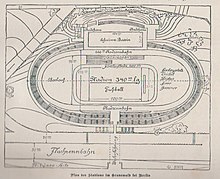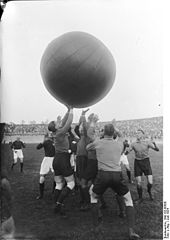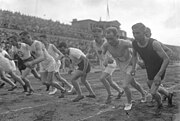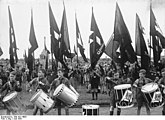German Stadium (Berlin)
| German stadium | |
|---|---|

|
|
| German athletics clubs run on March 30, 1923 in the German stadium | |
| Data | |
| place |
|
| Coordinates | 52 ° 30 '53 " N , 13 ° 14' 21" E |
| opening | June 8, 1913 |
| Renovations | 1927 |
| demolition | 1934 |
| surface | Natural grass |
| architect | Otto March |
| capacity | 33,000 seats (official) |
| Events | |
|
|
The German Stadium was a sports facility in what is now Berlin 's Westend part of the Charlottenburg-Wilmersdorf district in northern Grunewald, west of the then still independent city of Charlottenburg . It was inaugurated on June 8, 1913 at the same time as the 25th anniversary of the throne of Kaiser Wilhelm II . Since the formation of Greater Berlin in 1920, it has been in what was then Berlin's Charlottenburg district . It was designed by Otto March , who died during the 200-day construction period of the stadium, as the central facility for the 1916 Summer Olympics in Berlin , which did not take place because of the First World War . The German Stadium was demolished in 1934 for the construction of the Berlin Olympic Stadium on the same site.
Location and facilities
The stadium was located on the site of today's Berlin Olympic Stadium . It was sunk inside a horse racing track , the Grunewald Racecourse , which opened in 1909, and was only accessible through a tunnel. In addition to the soccer field, the sports facility had a 600-meter-long running track , enclosed by a 666-meter-long cycling track . On the north side of the stands, a 100-meter-long swimming pool was also built parallel to the soccer field, with the audience tiers set back, so that the stadium had an integrated swimming stadium. After its completion, the main stadium had 11,500 seats and 18,500 standing places. There was space for a further 3,000 spectators in the swimming stadium, so that the official capacity was 33,000. The spectator area could be reached via a tunnel starting from the main entrance on Stadionallee, today's Jesse-Owens-Allee . This was interrupted by a courtyard of honor, which was named Marchhof in honor of the architect who died during construction .

The swimming pool grandstand was framed by numerous sculptures that were created at short notice under the direction of Count Adalbert von Francken-Sierstorpff . Due to the short construction time, the sculptures were made in stucco , a mixture of plaster and cement. A later bronze casting of the sculptures was planned, but never took place. The goddess of victory Victoria by Ludwig Cauer was enthroned on a high column in the center of the swimming pool grandstand . The Neptune group placed on the base below came from Walter Schmarje . The swimming lane grandstand was framed by two equestrian statues of Ludwig Vordermayer and Hermann Fuchs . Six athletes ' sculptures were set up behind the swimming lane grandstand : Wrestler by Walter Schmarje, belt binder by Sascha Schneider , swimmer by August Kraus , athlete by Georg Kolbe , athlete and the sandal binder , both by Ludwig Cauer. The heavily eroded sculptures were removed in the summer of 1927.
history
Planning and construction
As early as 1907, the area was leased by the Union-Klub - the leading association for equestrian sports at the time - in order to build a racecourse there. At the same time, the German Reich Committee for the Olympic Games (DRAfOS) was looking for a site for a stadium to host the Olympic Games and decided on the racecourse site. Two years later, the Grunewald racecourse , designed according to Otto March's plans , was opened. At this point in time there was already an 85,000 m² excavated pit in the middle of the facility for the stadium construction, which was delayed due to financial problems. It was not until July 4, 1912 that Berlin was awarded the venue for the 1916 Summer Olympics that the stadium could be built, which Otto March was also commissioned to do. It was decided to use an earth stadium so as not to obstruct the view of the racetrack spectators. Only the imperial box and an opposite column impaired the view over the racecourse. After 200 days of construction, the 2.2 million mark building was completed. The architect himself did not live to see the opening, as he died on April 1, 1913. The stadium was opened on June 8, 1913 with a large stadium inauguration. On the same day, the underground service to the Stadion station began for the first time .
Events in the stadium
But the new stadium was not to experience any Olympic competitions: The First World War , which broke out in 1914, prevented the 1916 games, although they were never officially canceled. Instead, the German Stadium was closed from 1914 and used as a hospital from 1915 . It was not until 1916 that sporting competitions in the form of war championships took place again.
After the end of the First World War, the stadium was used again for civil purposes. A total of six games by the German national soccer team took place in the stadium. The first of these was also the team's first home game after the war, in which Hungary was beaten 1-0 on October 24, 1920 . It remained the only victorious game of the German national team in the German stadium. The finals of the German soccer championship took place in 1922-1924 and 1927 in the German stadium. The stadium saw the greatest number of spectators on June 10, 1923, when Hamburger SV and the Berlin club SC Union Oberschöneweide faced each other in the final . Around 64,000 spectators were present when the HSV Union defeated with 3-0 goals, almost twice as many as officially calculated. In return, the spectators not only occupied the not too steep areas of the cycling track, the base of the figurine decorations and even the roof of the former imperial box. The exceptional Finnish runner Paavo Nurmi won back the world record over the 3000 meter distance that he had lost the year before at the traditional stadium festival of SC Charlottenburg on May 24, 1926 .
Paavo Nurmi at the start of his world record run in 1926, the imperial box in the background
Hindenburg - Homage to the German school youth on October 2, 1927 in the German Stadium
An event of the Hitler Youth in 1933 in the German Stadium
Besides sporting events, the stadium was used for other major events. The central celebrations for the 80th birthday of Reich President Paul von Hindenburg took place here on October 2, 1927 as part of a large homage ceremony. On June 27, 1932, Adolf Hitler had a major campaign appearance . During the second flight to Germany, he used modern aircraft technology to be able to perform in several places in Germany every day.
German university for physical exercises
The newly founded German University for Physical Education found its first accommodation in 1920 in the premises under the swimming pool stand of the German Stadium. A first own building for the university was built in 1921 behind the swimming pool grandstand. Like the stadium, it was partially sunk. A small supplementary building later connected the university building directly with the stadium. Finally, from 1926, the German Sports Forum was built north of the racetrack , which eliminated the shortage of space at the rapidly growing university. However, some of the training operations continued to take place in the German Stadium.
The end of the stadium
The stadium was initially to be rebuilt for the 1936 Summer Olympics in Berlin. The swimming lane was to be relocated from the north side to the curve on the east side and the interior of the stadium was to be sunk deeper and made smaller, dispensing with the cycling track, in order to bring the playing field and running track to normal dimensions and to gain additional spectator seats close to the sports field. After the " seizure of power " by the National Socialists , the German Stadium was demolished in 1934 at Hitler's instigation and replaced by the Berlin Olympic Stadium , completed in 1936 .
Only the aforementioned access tunnel with the Marchhof have been preserved from the German Stadium, as well as the plastic Jüngling with the winner's armband by Paul Peterich , which was formerly placed there and is now exhibited in the Sports Museum Berlin in the House of German Sports on the nearby site of the German Sport Forum . During the construction of the underground car park for the Olympic Stadium in 2001, a row of columns was discovered that formed the entrances to the changing rooms on the west side of the swimming lane. The row of pillars was rebuilt in 2009 on the “women's meadow” of the Olympic swimming stadium .
Podbielski oak

The Podbielski oak that stood at the eastern apex of the grandstand is not preserved . The tree was significantly older than the stadium, which was built on a former forest area. It got its name in memory of Victor von Podbielski , who was an influential and committed supporter of the stadium construction and the Olympic bid for 1916. A commemorative plaque was unveiled on Podbielski's 70th birthday on February 26, 1914 in his presence on the plinth below the oak.
The Podbielski oak fell victim to the construction of the Olympic Stadium. An old sessile oak on the former racetrack area was declared the new Podbielski oak . It is located at the east entrance of the Olympic Stadium behind the ticket office and is under special protection as a natural monument . The Podbielski memorial plaque can be found at the marathon gate today.
Naming
In addition to the official name Deutsches Stadion , after the surrounding Grunewald racecourse, the name Grunewald Stadium was also used, especially in the press .
See also
literature
- Stephan Brandt: From the Grunewald racecourse to the Olympic Stadium. Sutton Verlag, Erfurt 2015, ISBN 978-3-95400-494-2 .
- German stadium consecration. Official stadium program. Berlin book and newspaper printing company Union, 1913.
- Noyan Dinçkal: Emperor's homage and obstinacy . The inauguration of the German stadium and the dawn of sport. In: Dieter Schott (Ed.): The year 1913. New beginnings and perceptions of crises on the eve of the First World War. Transcript Verlag, Bielefeld 2014, ISBN 978-3-8376-2787-9 .
- Volker Kluge : Olympiastadion Berlin - stones begin to talk. Parthas-Verlag, Berlin 1999, ISBN 3-932529-28-6 .
- Gerhard Krause: The German stadium and sports forum. Berlin 1926.
- Johannes Rehahn: The German Stadium. In: Christian Wolter: Lawn of Passions. The football fields of Berlin. History and stories. edition else, vierC print + mediafabrik, Berlin 2011, ISBN 978-3-00-036563-8 , pp. 87-95.
- August Reher (Ed.): The German stadium. Sport and gymnastics in Germany in 1913. Charlottenburg in 1913.
- Wolfgang Schächen , Norbert Szymanski: The realm sports field. Architecture in the field of tension between sport and power. bebra Verlag, Berlin 2001, ISBN 3-930863-67-7 .
- Hainer Weißpflug: The Podbielskieiche - a natural monument in the Olympic Stadium . In: Berlin monthly magazine ( Luisenstädtischer Bildungsverein ) . Issue 9, 1997, ISSN 0944-5560 , p. 80-82 ( luise-berlin.de ).
- Hainer Weißpflug: German Stadium . In: Hans-Jürgen Mende , Kurt Wernicke (Hrsg.): Berliner Bezirkslexikon, Charlottenburg-Wilmersdorf . Luisenstadt educational association . Haude and Spener / Edition Luisenstadt, Berlin 2005, ISBN 3-7759-0479-4 ( luise-berlin.de - as of October 7, 2009).
Web links
- www.die-fans.de
- stadtentwicklung.berlin.de (PDF; 328 kB)
- Stadium history - from the 19th century to the present day. Olympiastadion Berlin GmbH, archived from the original on November 12, 2007 ; Retrieved June 8, 2009 .
Individual evidence
- ^ August Reher (ed.): The German stadium . Sport and gymnastics in Germany 1913. Charlottenburg 1913. p. 23.
- ^ V. Kluge: Olympiastadion Berlin - Stones begin to speak. 1999, p. 38.
- ^ Stephan Brandt: From the Grunewald racecourse to the Olympic Stadium. Sutton Verlag, Erfurt 2015, ISBN 978-3-95400-494-2 , p. 30.
- ↑ See Hartmut Vollmer, Hans-Dieter Steinmetz: Karl May correspondence with Sascha Schneider. Vol. 93, Karl-May-Verlag, Bamberg / Radebeul 2009, p. 315.
- ^ August Reher (ed.): The German stadium. Sport and gymnastics in Germany 1913. Charlottenburg 1913. pp. 20–24.
- ^ Stephan Brandt: From the Grunewald racecourse to the Olympic Stadium. Sutton Verlag, Erfurt 2015, ISBN 978-3-95400-494-2 , p. 31.
- ^ Stephan Brandt: From the Grunewald racecourse to the Olympic Stadium. Sutton Verlag, Erfurt 2015, ISBN 978-3-95400-494-2 , p. 36.
- ↑ Dieter Busse: Paavo Nurmi runs a world record . In: Berlin monthly magazine ( Luisenstädtischer Bildungsverein ) . Issue 5, 1996, ISSN 0944-5560 , p. 81-82 ( luise-berlin.de ).
- ^ Stephan Brandt: Berlin-Westend. Sutton, Erfurt 2009, p. 116 f.
- ^ Stephan Brandt: Berlin-Westend. Sutton, Erfurt 2009, pp. 45-47.
- ↑ Columns for the Olympics ( Memento of the original from May 24, 2012 in the Internet Archive ) Info: The archive link was inserted automatically and has not yet been checked. Please check the original and archive link according to the instructions and then remove this notice. . Excavations on the Olympic site.
- ↑ The excavated portico from 1913 is visible again on the Olympic site. Press release from the Senate Department for Urban Development and the Environment. Berlin, May 7, 2009.
- ↑ Rehahn, p. 95, writes that replanting the tree would have cost 15,000 Marks without guaranteeing that the new location would be rooted.
- ^ W. Schächen, N. Szymanski: Das Reichssportfeld. 2001, p. 85.
- ↑ Ordinance on the Protection of Natural Monuments in Berlin of March 2, 1993 , p. 14. It is noteworthy that the oak is only protected because of its beauty, not because of its cultural and historical significance.





